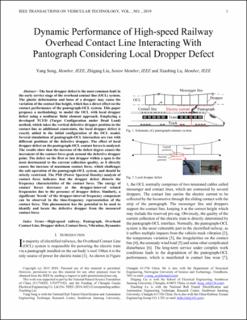| dc.contributor.author | Song, Yang | |
| dc.contributor.author | Liu, Zhigang | |
| dc.contributor.author | Lu, Xiaobing | |
| dc.date.accessioned | 2020-09-14T09:17:31Z | |
| dc.date.available | 2020-09-14T09:17:31Z | |
| dc.date.created | 2020-08-06T10:06:31Z | |
| dc.date.issued | 2020 | |
| dc.identifier.citation | IEEE Transactions on Vehicular Technology. 2020, 69 (6), 5958-5967. | en_US |
| dc.identifier.issn | 0018-9545 | |
| dc.identifier.uri | https://hdl.handle.net/11250/2677594 | |
| dc.description.abstract | The local dropper defect is the most common fault in the early service stage of the overhead contact line (OCL) system. The plastic deformation and loose of a dropper may cause the variation of the contact line height, which has a direct effect on the contact performance of the pantograph-OCL system. This paper proposes a methodology to model the OCL with local dropper defect using a nonlinear finite element approach. Employing a developed TCUD (Target Configuration under Dead Load) method, which takes the vertical defective dropper position in the contact line as additional constraints, the local dropper defect is exactly added in the initial configuration of the OCL model. Several simulations of pantograph-OCL interaction are run with different positions of the defective dropper. The effect of local dropper defect on the pantograph-OCL contact forces is analysed. The results show that the increase of the defect degree causes the increment of the contact force peak around the defective dropper point. The defect on the first or last dropper within a span is the most detrimental to the current collection quality, as it directly causes the increase of maximum contact force, which challenges the safe operation of the pantograph-OCL system, and should be strictly restricted. The PSD (Power Spectral Density) analysis of contact force indicates that the dropper defect distorts the frequency characteristics of the contact force. The energy of contact forces decreases at the dropper-interval related frequencies due to the presence of dropper defect. Similarly, a significant `break' of the dropper-interval frequency component can be observed in the time-frequency representation of the contact force. This phenomenon has the potential to be used to identify and locate the defective dropper from the measured contact force. | en_US |
| dc.language.iso | eng | en_US |
| dc.publisher | Institute of Electrical and Electronics Engineers (IEEE) | en_US |
| dc.title | Dynamic Performance of High-Speed Railway Overhead Contact Line Interacting With Pantograph Considering Local Dropper Defect | en_US |
| dc.type | Peer reviewed | en_US |
| dc.type | Journal article | en_US |
| dc.description.version | acceptedVersion | en_US |
| dc.source.pagenumber | 5958-5967 | en_US |
| dc.source.volume | 69 | en_US |
| dc.source.journal | IEEE Transactions on Vehicular Technology | en_US |
| dc.source.issue | 6 | en_US |
| dc.identifier.doi | 10.1109/TVT.2020.2984060 | |
| dc.identifier.cristin | 1821958 | |
| dc.description.localcode | © 2020 IEEE. Personal use of this material is permitted. Permission from IEEE must be obtained for all other uses, in any current or future media, including reprinting/republishing this material for advertising or promotional purposes, creating new collective works, for resale or redistribution to servers or lists, or reuse of any copyrighted component of this work in other works. | en_US |
| cristin.ispublished | true | |
| cristin.fulltext | postprint | |
| cristin.qualitycode | 2 | |
